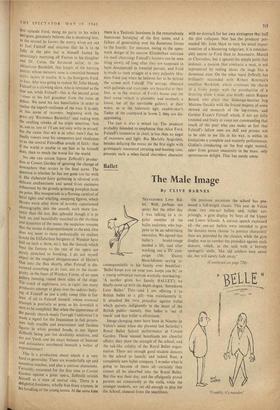Ballet
The Male Image
By CLIVE BARNES 'STEVEDORES Love Bal- let.' Well, perhaps not quite; but the other day I was talking to a re- gular member of the ballet audience, who hap- pens to be an advertising executive. We agreed that ballet's brand-image needed a lift, and after working out a TV cam- paign (Mr. Danny Blanchflower saying in- consequentially to his family over breakfast: 'Ballet keeps you on your toes, keeps you fit,' or a young subtopian matron wistfully murmuring: 'A mother gives her family BALLET') we finally came up with the depth slogan, 'Stevedores Love Ballet.' This—and I am offering it to British ballet as a gift--was translucently it. It attacked the twin prejudice against ballet which quivers indignantly in the heart of the British public—namely, that ballet is 'out of touch' and that ballet is effeminate.
Image-changing must have been in Ninette de Valois's mind when she planned last Saturday's Royal Ballet School performance at Covent Garden. These annual beanfeasts are cheerful affairs; they show the strength of the school, and the oak-like solidity of the Royal Ballet organ- isation. There are enough good student dancers in the school to launch, and indeed float, a completely new ballet company. I wonder what is going to become of them all—certainly they cannot all be absorbed into the Royal Ballet. But this was their day, and the effulgently proud parents sat contentedly in the stalls, while the younger students, not yet old enough to play for the School, shouted from the touchlines. On previous occasions the school has pro- duced a full-length classic. This year de Valois chose two one-act ballets and, rather sur- prisingly, a gym display by boys of the Upper and Lower Schools. A curtain speech explained all—the one-act ballets were intended to give the dancers more chance 'to portray characters' than are provided by the classics, while the gym display was to combat the prejudice against male dancers, which, as she said with a bravely apologetic smile, 'like old soldiers may never die, but will surely fade away.'
(Continued on page 720)
The Royal Ballet School is often accused, sometimes fairly, of producing dancers like rabbits out of a hat, and with as much indivi- duality. At this performance whatever individua- lity they may have had was strangled by a production of Pineapple Poll that seemed nothing short of deplorable. The details of the choreography had only been sketchily remem- bered, while the staging would have brought little credit to an amateur musical comedy in one of the less enlightened London suburbs The climax of this ineptitude came when the un- fortunate dancers were allowed or it may be forced, to take cute little curtain calls in character. After such barbarous vulgarity, the astonishingly tough and invigorating perform- ance of Les Patin,eurs came as a most pleasurable bombe surprise at the end of the programme.
The gym display, holding place of honour between these two ballets, turned out to be quite unremarkable. The boys did exceptionally well, which was only to be expected from pupils of a school that by its very nature concentrates on physical training. But the spectacle of boys in singlets and shorts vaulting over a horse hardly made enthralling theatrical entertainment, even though some of them were jumping like potential Olympic champions. However, if such displays do indeed contribute to a more sympathetic pub- lic understanding of the athletic nature of male dancing, then it may not be wasted.
Effeminacy is no longer a particularly serious problem in British ballet. The probleM has never been directly related to homosexuality; the most heterosexual ballet dancer can easily be a
camp-follower on stage. Lately, however, effemi- nate dancing has become rare, the dancers them- selves being now acutely aware of the danger of it. When this fact becomes more widely realised,
as in the course of time it must, most of the pre- judices against male dancers will vanish of their own accord Dancing is more natural for men than for women.







































 Previous page
Previous page